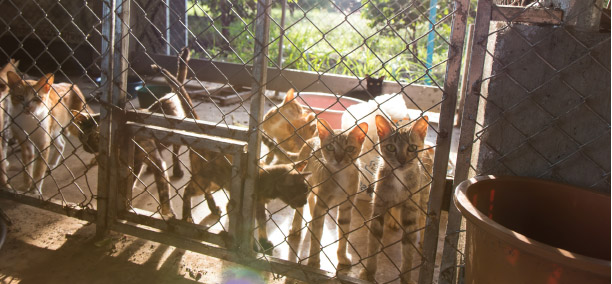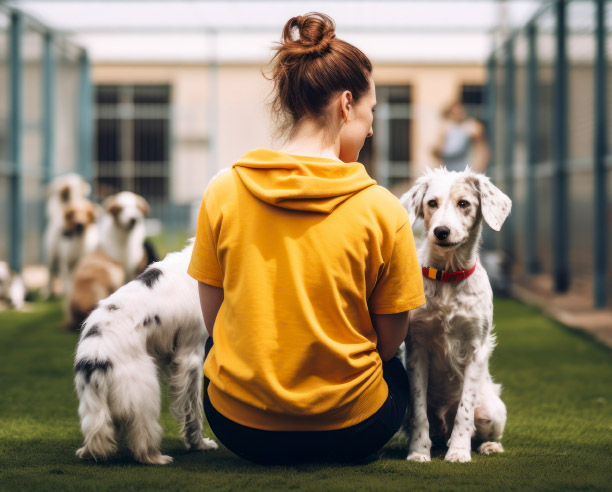ADOPTION CRISIS
Why Are Shelters Full?

Before the COVID-19 pandemic, the rescue and advocacy communities were finally in a good place. Adoption rates were at their highest in history. Municipal shelters that must euthanize when at capacity to make space for more homeless pets became the exception rather than the norm. Sadly, euthanizations for space were still happening, but they were few and far between compared to just a few years prior.
Then the pandemic hit and the most amazing thing happened; adoption rates skyrocketed. People realized they were going to be in lockdowns for an undetermined period of time, and they didn’t want to be alone. Many headed to their local municipal shelter to find a furry friend. Adoption rates shattered every record on the books as everyone was being sequestered to their homes. Virtually every shelter and rescue across the country were reporting almost no populations in holding.There has never been a time in recordable history that this has happened.
Before we get into what happened next, there are a couple of definitions you need to understand:
• Live Release Rate: Live Release Rate is calculated based off the total number of live outcomes divided by the total number of outcomes from the shelter. In other words, the Live Release Rate is the percentage of animals that come out of a shelter or shelter system alive (be it through adoption, rescue transfer, etc.
• Return Rate: The return rate is calculated based off the total number of animals returned to a shelter or shelter system divided by the total number of adoptions. A typical return rate averages around 7%.
THE WORLD RE-OPENS
After more than two years of lockdowns, social distancing and masking up, our world was finally re-opening. And then the unthinkable happened; the return rate for shelters soared to new heights.
Once employers began insisting that their employees return to the office, a large portion of those dogs and cats were returned to the shelter or rescue they were adopted from. Many citing that they struggled to care for the animal during the pandemic because they had never had a pet before and didn’t realize what it really required. Others citing that they no longer had time to care for their charge.
But those return numbers are not as high as many media outlets initially stated. The average return rate for a shelter pre-pandemic hovered at between 5 and 7%. Post-pandemic, that number soared to between 14 and 28% depending on the municipality and the conditions during the lockdowns. As an example, return rates in New York City were far higher than they were in Miami. Some market analysts suggest it was because there were far less restrictions in Florida than in New York State, allowing the population to return animals during the pandemic, spreading the return rate more evenly across a fairer amount of time.

The real tragedy here is that you cannot explain to a dog or a cat why they are being returned to a life behind bars. They only feel a sense of abandonment. It is the worst thing you can do to an animal which is why the rescue and advocacy communities worked tirelessly for years to drive down the return rates in shelters.
Our own Editor-in-Chief and Co-Publisher, Sean-Patrick M. Hillman, worked with Animal Care Centers of NYC (ACC) in the early 2010’s to install adoption counselors at their facilities in New York City when the shelter system was being updated and new policies put in place. As he explains it, “When my wife and I started our animal advocacy, ACC’s live-release-rate was one of the lowest in the country. This was when ACC was being poorly managed, and the city had little to no interest in change. While Mayor Bloomberg put on a good face, the truth is that the community is who changed the paradigm, not the policies his administration claimed.
The return rate for adoptions was also abnormally high and we knew why; people didn’t understand the responsibility they were taking on and ultimately returned those adoptees to the shelter. There were also unusually high instances of animals being returned due to unknown allergy-victims like children who had never played with a pet before.
You also had issues where people didn’t realize they had lease restrictions wherein they could only have one pet or a pet that maxed out at 25 pounds. As great as adopting is, if you have to return that pet because you didn’t check the terms of your apartment lease that is just wrong on every level. The counselors were there to ask questions about their lives and lifestyles to better prepare them, and guide them, to adopt the right kind of dog or cat for them. That was just one aspect of how we worked with the community to help ACC achieve a much higher live-release-rate of 93%. A rate which Best Friends Animal Society classifies as ‘No-Kill.’ ACC today has far better management and protocols to help save as many furrever ones as possible. Granted we live in a very different situation in post-pandemic New York.”
Sean-Patrick is right in that the reality in this post-pandemic world is far different. Like many other municipalities, ACC is suffering from overcrowding and has been forced to euthanize once again to make space for more homeless pets brought to their door. These municipal shelters have not recovered from the pandemic, with more and more animals being brought to their door every day. It is known as a quicksand effect wherein these facilities are trying to dig themselves out in all of the right ways. The problem is that there are too many animals being surrendered, and not enough people are adopting due to perceived costs thanks to inflation. At least that is what most analysts believe is the root cause for lower adoption numbers.








